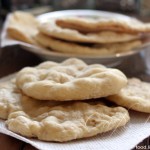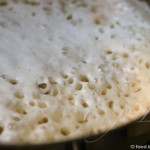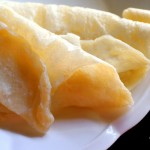
Jachnun is one of those dishes that everyone in Israel loves but few actually make themselves. These rolled sticks of dough are a Yemenite Jewish food. The dish is one of many slow-cooked Jewish foods invented to be prepared a day in advance and baked all night long, so that there would be hot food on the sabbath, when lighting fires is prohibited.
Brought over by Yemenite immigrants from Aden, jachnun was warmly embraced by Israeli society as a whole. Originally, it was baked under the coals in families’ outdoor tabouns, recall immigrants’ children. It’s traditionally served here with grated fresh tomato, skhug (Yemenite hot sauce), and a hard-boiled egg, cooked in the pot along with the dough. You can find it sold at roadside stands, restaurants and rest stops; for those who want to feel like they’re making it themselves, you even can buy it frozen at the supermarket. All you have to do is fit the frozen logs into a jachnun pot and bake overnight.
Mind you, there are people still making jachnun from scratch. (There are supposedly even people still baking it under coals — though not many.) It’s not too difficult — you make a dough of flour, white sugar and water, roll it out thinly, coat liberally with margarine and roll it up. Yemenite filo dough. Yes, this is one unhealthful food. But fortunately, if you’re making it yourself, you have some control over that.
Most modern-day jachnun recipes include white flour, white sugar and margarine. This is a modern development — the white flour was once whole wheat and the margarine was clarified butter, say Yemenite quarter residents. The sugar was probably date syrup, if it was used at all.
Few people prepare it that way today — the perception is that there’s no demand — but there’s no reason not to. Dough made with white flour is more elastic and can be stretched thinner, but I found the whole-wheat jachnun to be more satisfying — you’re not eating empty calories for breakfast. Either way, you’ll be full for hours afterward.
I also used olive oil in place of the margarine, which made my jachnun drier and distinctly not greasy. Using clarified butter, known as samneh, is also a viable (non-parve) option, and this gives the jachnun a lovely flavor you won’t find in the commercial variety.
I sometimes bake my jachnun in a slow-cooker instead of in a metal pot in the oven. It works.

Rolling out the jachnun
Jachnun gets its flaky texture from layers upon layers of rolled dough. As I was examining jachnun pots at the market, a nearby jachnun/falafel vendor started asking me if I make it myself — rolling out the dough and all. I told him I did.
Don’t use a rolling pin, he told me.
Oh?
You can’t get it thin enough with a rolling pin, and a rolling pin will rip the dough, he said. He starts with an egg-sized ball and stretches it out to a a 50-by-50 centimeter square. The secret is he adds just enough water so that the dough is springy — it should bounce back if you poke it — and then he lets the dough sit an hour, so that the glutens develop and it becomes more elastic. (I find that letting it sit overnight makes it even more elastic.)
He doesn’t use whole wheat flour, by the way, because it’s not stretchy enough.
So that’s the proper way to do it — one of them, at least. I’m not quite there yet, and my layers are probably a little thicker than his. Plus, the dough isn’t as elastic if you use whole wheat flour and not white flour. But the final product still tastes good to me.
A few other things before I start the recipe: I sprinkled dried powdered yeast on the rolled-out dough, along with the oil. I only found one reference of someone else who did this, but I liked the light flavor and slight airiness it added.
Also, this recipe will make six jachnuns. You might want to make twice this amount. Or make six whole-wheat jachnuns and six white flour ones, which is what I did.
Note: I’ve tagged this recipe as parve and vegan because the jachnun itself is parve and vegan. Serving it with eggs will make it not vegan, and using butter instead of oil will make it dairy, and not parve or vegan.
For six jachnuns:
500 grams (3.25 cups) whole wheat flour (alternative: white flour)
1/4 cup date honey a.k.a. silan (alternative: sugar)
1/2 teaspoon baking powder
1 1/2 teaspoons salt
1 1/4 cup water, or enough to give you a springy dough
1/4 cup oil, or more if needed (alternative: about 100 grams margarine or butter)
dried powdered yeast (optional)
stale bread or pita to line the pot
Condiments (which we’ll use later):
eggs
tomatoes
skhug
Mix the flour, date honey, baking powder, salt and water to form a dough. It will be sticky, and that’s OK. Knead and let sit for at least 10 minutes. Some people say it needs to sit overnight, but that’s not a consensus; I strive for an hour. Knead again and let sit again. The waiting makes the dough easier to work with and lets the gluten develop.
Divide into six balls. They’ll be about the size of tennis balls.

Oil your work surface. Using your hands and/or a rolling pin, roll out the dough into a 40-by-40 centimeter (16 inch) square. Oil it as needed. The dough should be very thin. If it tears, try to push it back together, but it doesn’t really matter — once it’s folded, the imperfections won’t be noticeable.
Rub liberally with olive oil (or softened margarine or butter — about 1-2 teaspoons oil, 2 teaspoons butter or 1 tablespoon margarine); sprinkle lightly with yeast (if using).

Fold over into thirds. You now should have a long, narrow strip. Brush oil on the top layer.

Roll out again in both directions. Your strip should now be wider and longer. The width of the strip will be the length of your finished jachnun.

Start rolling up the strip. Pull the dough as you go, to stretch it out even more.
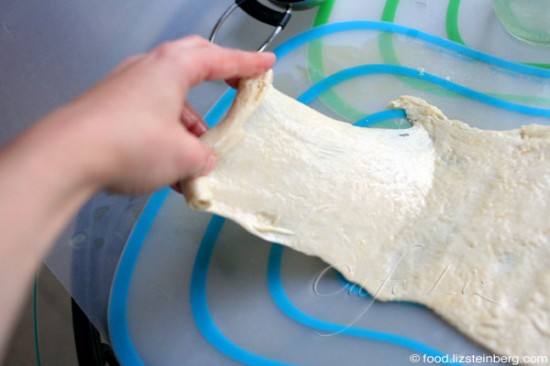
Here’s the finished roll. (See? None of those tears are visible anymore).

Arrange a thin layer of stale bread on the bottom of your baking dish or slow cooker. The bread pads the jachnun and absorbs excess oil. The traditional jachnun pan is a cylindrical metal tub with a tight-sealing top, but you can use any oven-safe dish with a tight lid.
Cut strips of baking paper slightly larger than each jachnun. Rest each roll on its strip of paper — this isn’t necessary, but it will keep them from sticking to each other and falling apart when you remove them from the pan.
Arrange the paper-coated jachnuns in the dish. They should be packed relatively tightly.
If you want, arrange a few clean eggs in with the jachnun. They’ll come out hard-boiled.
Cover with tinfoil to help preserve moisture, seal the pot and bake overnight, for 10-12 hours — on the low setting of your slow cooker, or at 100 to 110 degrees Celsius (210 to 230 Fahrenheit) in your oven. Once baked, whole wheat jachnun will come out nearly chocolate colored; white flour jachnun will be light golden.
Prepare the condiments:
Serve with grated tomato, skhug or hot pepper sauce, and hard-boiled eggs.
To grate the tomatoes, simply slice them in half and grate the cut side. You’ll get tomato pulp, and the peel will be left in your hand.
For me, one serving is one jachnun, one grated tomato and one egg, but these ratios vary by taste.
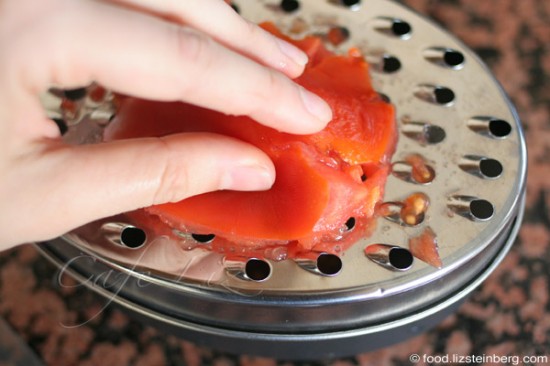
Bonus recipe: Malawach
Malawach is another Yemenite bread. It’s made from the same dough as jachnun, but instead of being rolled up, it’s folded into sheets and fried in a pan. One of the balls in the above recipe would make about a 20-by-20 centimeter (8 inch) malawach.
Fry the dough on both sides, and serve with the same condiments — tomato and egg. Or use other condiments of your choice.
We had something similar in Egypt, and there it was called “Egyptian pizza.”
More:
- A video on how to roll jachnun (it’s in Hebrew, but few words are involved)
- How to make lahoh, another kind of Yemenite bread



